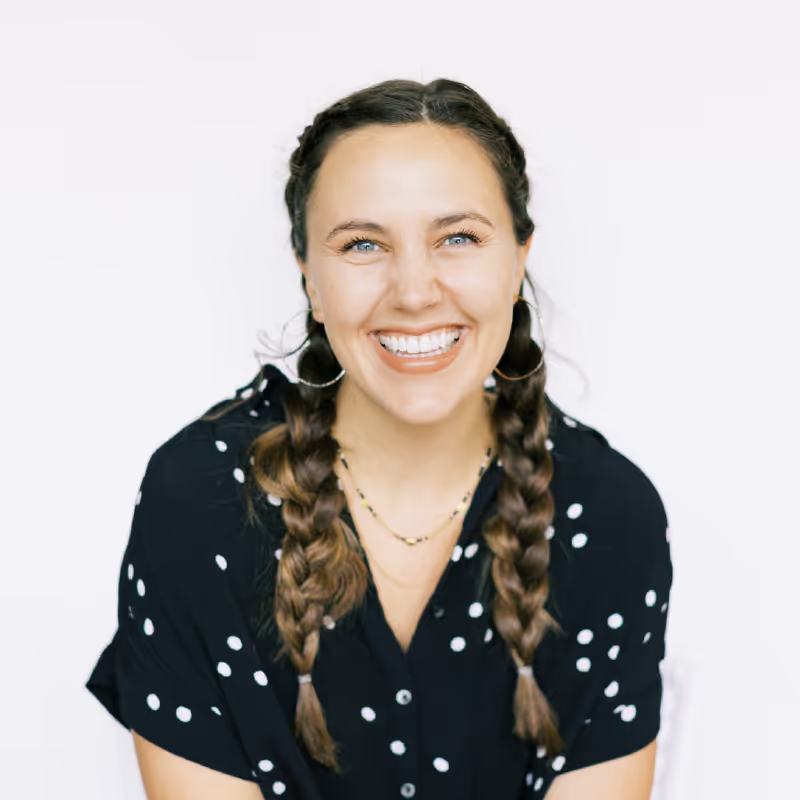
Articles
The Best Hiring Process (From Start To Finish)
March 11, 2021
.png)
Your hiring process matters big time! That's because you're not just filling desks. You're investing in the people who will keep your business running.
So, you want these people to be passionate about what your company does. That way, they stick around for the long haul.
But, admittedly, securing top talent that is both qualified and genuinely cares is easier said than done. And it requires a lot of time and effort upfront.
But by focusing on leveling up (and standardizing) your hiring process, you can secure top candidates that might just prove to be your next top player. Here's how:
Set your hiring process up for success
There's a common misconception that your hiring process starts the moment you post the job listing. But it doesn't. In fact, roughly 50% of the process happens well before you even get to that point.
That's because before you can start searching for a candidate, you need to know what exactly you're hiring for and why. Otherwise, chances are good you'll waste the wrong candidate's time, tons of resources and probably make a bad hire (no thanks).
But by investing in your hiring process upfront, you can provide every candidate a consistent and equitable hiring process. Meaning, you secure the best candidate every time.
So, before you even think about posting that job listing, ask yourself these 4 questions first:
1. Why should someone care about joining your company?
When you post your job listing, you want everyone who applies to think: “this company gets me. I have to get an interview with them.”
But in most cases, this doesn't happen. Because candidates don't know if they align with your company unless you give them the means to figure this out. A blurb about your company, your mission, and your values included.
If you don't do this, you'll get the people who apply for every job on the internet. And I can promise you those won't be your best hires.
And while you might be thinking that if they want the job, they'll do this work themselves - chances are good won't.
The results? Small businesses see roughly 46% of new hires turn over within 18 months. That's because 89% of those new hires feel misaligned with their role and the company’s culture. And on average, you spend over $4k and 42 days to find their replacement (which adds up quick).
Instead, gather a quick blurb about your company, your mission, and maybe even your values. Then, sum them all up in a few clear sentences.
You'll want to add this to every job description, job listing, careers page, whatever your prospective candidates might be looking at! That way, you start getting applications from people who are more likely to stay long-term).
For example, we tell all our prospective candidates that:
“Trainual is an early-stage, venture-backed SaaS startup that provides an easy way for SMBs to document what they do. AKA we keep teams aligned, put training on autopilot, and help businesses scale faster!
And we’re growing fast ourselves, so we’re always looking to add super talented folks to our team!”
2. Why are you hiring for this role now?
As your company grows, you can't just look around and know what roles you need to hire next. You need the leaders on each team to let you know what role they're missing.
And the best way to do that is by meeting with all your people leaders routinely. Just make sure you're checking for the nuanced problems (such as burnout) - not just the glaring ones (such as missed deadlines). That way, you can hire proactively rather than play catch up.
For example, your People Ops team might host:
- Weekly check-ins with the people leaders from each department to discuss any challenges, roadblocks, and potential headcount changes on the horizon
- Monthly meetings with the appropriate stakeholders (like Finance and your C-suite) to get a sense of where the business is at - and if you're ready to bring on another team member
- Quarterly meetings to forecast what roles (if any) you'll hire in the next quarter
Of course, this is how we do it at Trainual. But feel free to take this cadence and find your own rhythm. Just make sure you have some sort of strategy to help you fill the right roles at the right time.
Once you know what role to fill, take time to fully explore what exactly it is you'll be hiring for. You might have hired this role before and already have a solid understanding of what you're looking for.
But if it's a new role, or you're rethinking the role - get specific. Is this role full-time? Part-time? What responsibilities will this role take on immediately? How will this position grow in a few months? A year?
3. Are all the stakeholders aligned on the hiring process?
Before you even post the job listing, fully align your stakeholders on the hiring process. This includes department leaders, People Ops, Finance, and anyone else involved in the process. Don't forget to double-check that you've tapped all the right people in!
You'll also want to clearly communicate to your team exactly what you're hiring for. That way, everyone is on the same page for what role you're filling and how it will support your current team.
If you decide not to tell everyone what you're hiring, you risk your hiring process turning into a game of telephone. Meaning, a lot of misinformation, spreading fast. And a lot more unnecessary frustration when expectations aren't met. (And spoiler: it's more of a headache than anything else.)
Prioritizing diversity in your hiring process
If you wait until after the hiring process to focus on diversity and inclusion, you'll never get it right. Instead, it'll be more like putting a bandaid on a broken bone.
But by making sure your hiring process is diverse and inclusive, you'll naturally get a more well-rounded team and healthier company culture. And I know that's something everyone and their mom has been saying lately - but it's true.
Teams with higher age gaps, more diverse gender identities and different geographical and racial backgrounds were 87% more likely to make better business decisions. Because of this, these companies are also more profitable and see more long-term growth.
Here are a few plays to help you fill your pipeline with diverse talent:
Opt for outbound sourcing
Meaning, reach out to top talent - rather than hoping that they'll come to you. This way, you can make sure your candidate pool is diverse. So you can pick the best candidate for the role - not just get stuck with an okay one.
Keep your pipeline diverse
Fill your pipeline with 4 diverse candidates for every one non-diverse candidate. Meaning, look for people who will bring different backgrounds and experiences than your current team (these are all diverse candidates). That way, you're more likely to hire someone who brings new perspectives and finds blind spots.
Use neutral language
A lot of language is coded in gender - even if you don't intend it to be. So, use neutral language in your job description (like "they" or "you"). That way, you don't accidentally alienate anyone. For example, when you describe a role as a "supervisor" instead of a "rockstar," more candidates see themselves joining the team and apply.
Focus on must-have skills
Write job descriptions with only your need-to-have skills. When you also include the nice-to-haves, super-qualified candidates (notably, female candidates) will actually self-select themselves out of the running. That's because women tend to apply for roles they are 100% qualified for, whereas men will when they're only 60% qualified.
Your hiring process checklist
Like gathering all your ingredients before you start cooking, you'll want to build all your hiring resources before you start looking. And the easiest way to do that is with a hiring checklist. That way, everyone gets the same seamless experience every time you hire.
Here’s, bare minimum, what you’ll need:
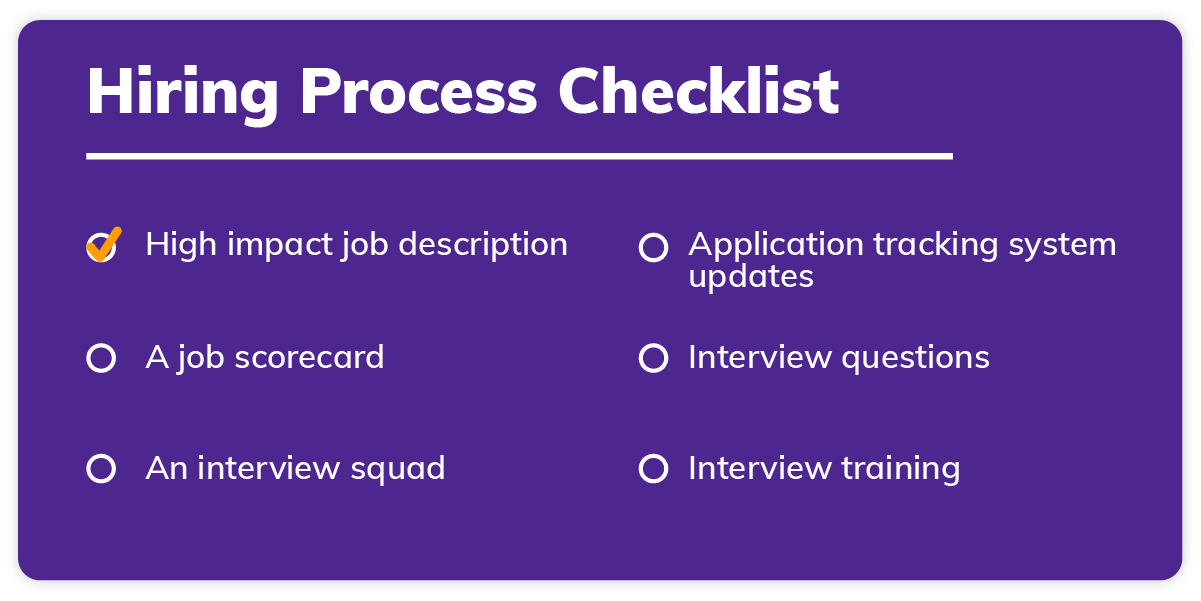
👉 Double check that you have everything you need to start hiring. Get the checklist.
1. High-impact job description
Job descriptions are kind of make or break when it comes to finding the right candidates. So, we like to think of them as an ad for your role.
Instead of just listing out some skills you’d like to see, take the time to give your candidate a taste of what working for your company will actually be like.
Of course, you'll describe the role. But you should also dive into the overall employee experience at your company and let them know how you'll measure success in the role.
🔥 Tip: Once you’ve solidified what you want to include in your job descriptions, make it into a template! That way, every role gets the same impactful job description, and you aren’t starting at square one every time.
We've dubbed our job descriptions: "impact descriptions." Because they focus on the impact that the role will have on the company, set expectations for what success looks like, and give them a sneak peek on how they can level-up. Because of all this, we get super qualified individuals to apply.
Here's how we break down all this information to make it digestible for the applicant.
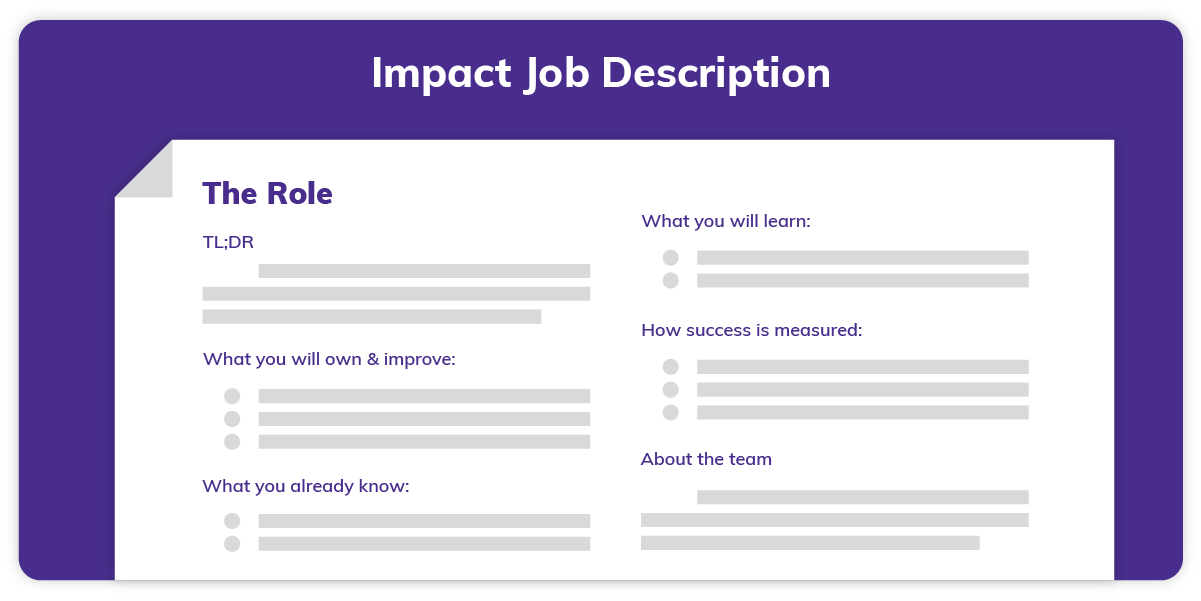
- TL;DR. A short and sweet section that hones in on the person we’re looking for. If this is all they read, they should know whether they're the right fit.
- What you will own and improve. Here, we clarify what responsibilities this position will own.
- What you already know. A quick breakdown of the skills they absolutely must have before applying (AKA the skills we won't teach them).
- What you will learn. We’re big believers in planning for our employee's growth. So this is a quick breakdown of the skills they don't need to have before applying (AKA the skills we will teach them).
- How success is measured. Plus, we include specific success metrics. So, there are no surprises how we'll hold them accountable if they get the job.
- About the team. Who the role will report to (and if it's a people leader position, who will be on their team).
👉 Love how we write our job descriptions? Feel free to snag our impact description template and make it your own. Get the template.
2. A job scorecard
Nearly half of employees worldwide aren’t actually sure what's expected from their role. Which ends up being a huge miss in terms of productivity and employee happiness.
And while your job description should provide a great starting spot for setting these expectations, roles evolve quick. So, we like to go one step further and provide every employee with a detailed job scorecard. That way, there are no surprises come review time.
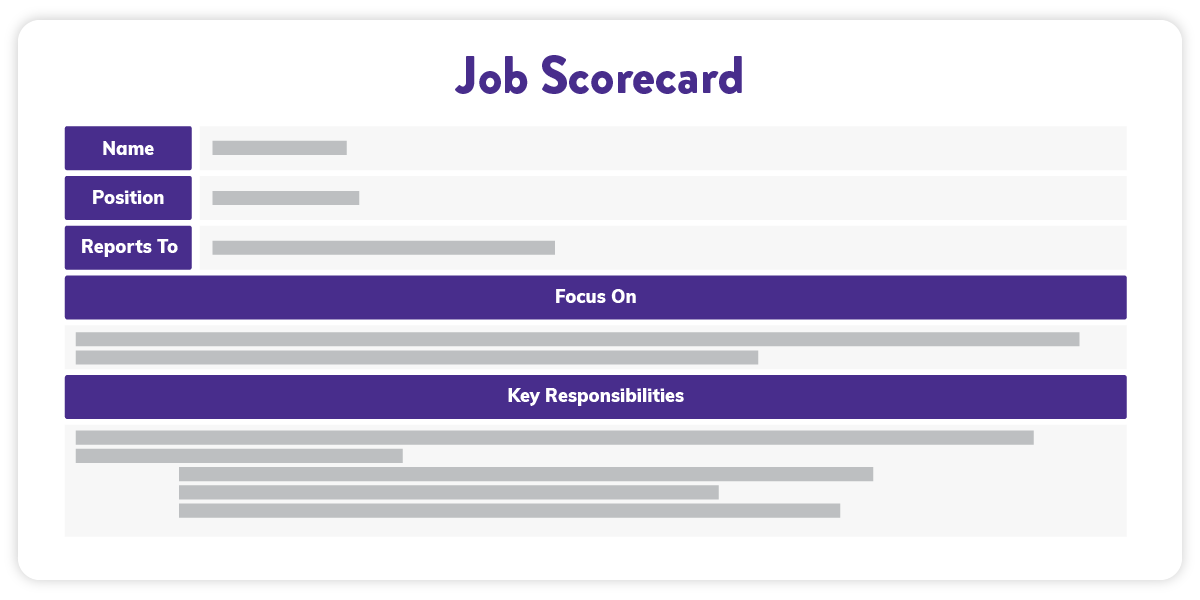
This scorecard clarifies all the new hire's main focuses, key responsibilities, and success metrics. And these metrics can be anything from increasing organic traffic to response time to customer satisfaction. Just be sure that you have a process to accurately measure these numbers.
Plus, it lets them know how their work directly helps the company achieve its goals.
For example, if I were to hire a People Ops Generalist for my team, their job scorecard would include their goals. But it would also highlight their overall contribution to the company:
"The Pops Generalist is an advocate and evangelist for the employee experience at Trainual. All their programs and initiatives facilitate an inclusive, growth-oriented culture that reduces employee churn and drives increased engagement."
Just keep in mind that over time the role will evolve, and the expectations will change. So, make sure you take time (about once a quarter) to make sure the job scorecard has all the right information and update it if it doesn't
👉 Make sure every employee's score card has everything they need. Get the template.
3. An interview squad
With your job description and scorecards built, it's time to assemble your interview squad! AKA anyone that will touch base with the candidates throughout the hiring process.
You'll give each of them a copy of both the job description and the scorecard. Then, give each stakeholder a run-down on what the hiring process will look like from start to finish. Be sure to clarify when each stakeholder will be involved in the process.
We like to structure our interview process linearly from People Ops to the actual team, from highest-level to lowest-level. Meaning, the candidate talks to People Ops, the department head, their direct manager, then the team.
And because you don't want candidates to repeat through the same conversation for everyone, each interview should focus on slightly different aspects of the role.
This might mean that the first interview with People Ops focuses on role and value alignment. While the second interview with the department head dives into the relevant past experience.
For there, we suggest setting up cross-functional interviews with all the other stakeholders (direct manager and team). That way, you can make sure they have amazing chemistry with your existing employees before adding them to the team.
4. Application tracking system
Add the role to your applicant tracking system (like Lever). That way, you can easily see who's applied, what stage each candidate is in the hiring process, and collect feedback.
That way, you can keep your hiring process organized in one centralized place. And easily share portfolios, resumes, and cover letters with stakeholders before they interview the candidate.
When applicants start getting added to your applicant tracking system, schedule the interviews and assign each interviewer to a stakeholder. That way, your hiring process is more or less on autopilot once you set the job description live.

Just make sure that every stakeholder fills out the same feedback form in your applicant tracking system after the interview. This is an easy way to ensure that everyone is being evaluated the same way.
5. Interview questions
There’s nothing worse, or less helpful, than repeating the same 5 questions in every interview. Not only does it waste the candidate's time, but you'll probably get the same 5 answers back.
So, determine questions ahead of each interview. And have these questions customized to the role and what you're trying to get from the interview.
We like to set our stakeholders up with a list of company culture-related interview questions. Then, each stakeholder calls dibs on the ones they'd like to ask. Our People Ops team collects all these questions and puts them in the order that they best flow. This way, there are no awkward silences or jarring transitions. Plus, no wildcard questions that could be misinterpreted.
Just make sure to standardize questions about past experience and skills. That way, you remove personal biases that come with vacationing in the same place and make the criteria more objective. When everyone answers the same question, it's easy to see who'd be the best candidate.
6. Interview training
Interviewing isn't a natural skill for tons of people - and often, the interviewer can be just as nervous as the candidate. Not to mention the fact that as much as you're interviewing your candidates, they're also interviewing you.
So, put your team's best foot forward with interview training. That way, everyone your candidate meets asks the right questions and is prepared to answer anything that comes their way.
Plus, when done right, interview training helps stakeholders become more aware of their unconscious biases. Which helps keep these biases out of the hiring process.
For example, interview training will cover what types of questions are appropriate to ask a candidate. Because while it might feel totally normal to ask about their spouse or kids when you meet someone out and about, it's wildly inappropriate during an interview.
For starters, personal questions like this can lead to the interview's biases getting in the way. But it can also feel discriminatory on the candidate's end. So, it's best to focus on credentials, experience, and topics that evaluate if they're the best fit for the role.
🔥 Tip: House your interview training in Trainual. That way, you can easily track that all the stakeholders went through it before meeting with candidates. Try for free.
The hiring process timeline
At this point, the heavy lifting is out of the way. And all you need to do is keep candidates coming into your pipeline and moving through your hiring process.
This process (like all your other processes) should be standardized. That way, every candidate gets the same smooth experience. And because you did all the preparation up front, you should be able to close a role in as little as 2 weeks - from the time it's posted.
We even like to set a deadline (usually about 2 months after we post the job) for how long a role can stay open. And we communicate that deadline to all our stakeholders. That way, we have a bit of pressure to keep things moving.
So, here's the best hiring process for getting your role across the finish line quickly:
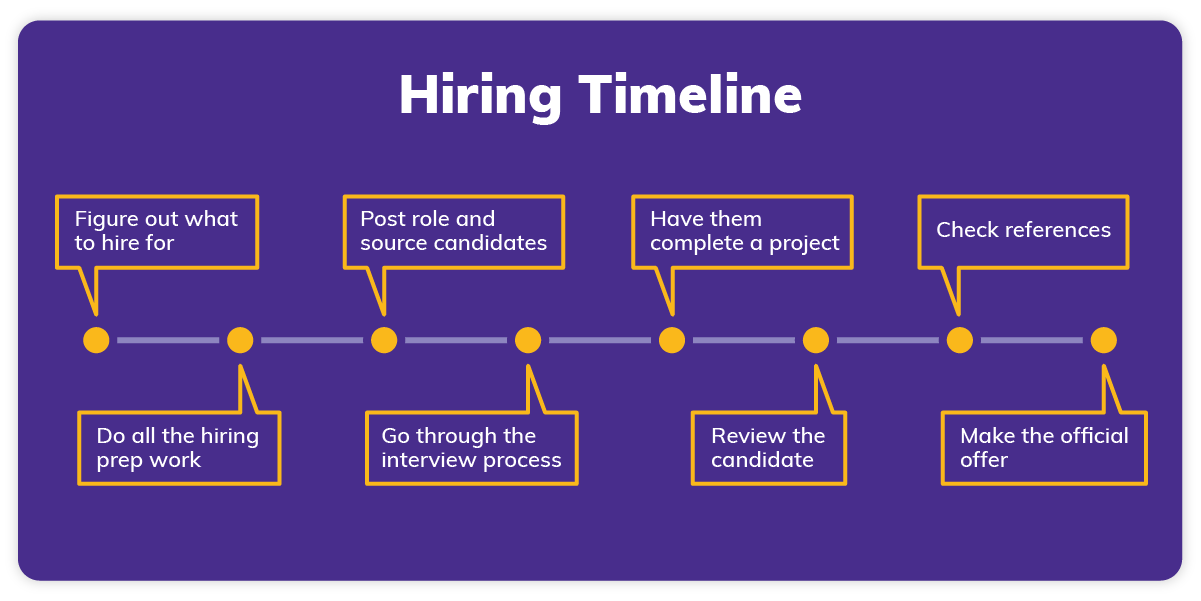
Prepare to hire
That 50% of your hiring process you do upfront? Yep, we meant right off the bat!
Start meeting routinely with all your people leaders to talk about headcount immediately (if you haven't already). And when you decide you're ready to hire your next role, clarify what it is exactly.
Then, using the information, go through your hiring checklist. Be sure to create all the resources you need, tap in all the stakeholders, and get everything ready to go.
Post the role
Then, set your job live. After all, how else are you going to attract top talent? (Once the job listing is live, don't be afraid to reach out to initiate the conversation with potential candidates.)
And while it might be tempting to skip this step and use referrals instead, it's not the best idea.
For starters, this makes outbound sourcing nearly impossible. Because without a formal listing, the job doesn't seem legit. So, you'll be forcing yourself to find a candidate primarily through your team's references.
And while this might be easier, chances are good the people in your team's network reflect the people on your team. So, this approach probably won't bring the most diverse talent. Meaning, it also likely won't bring in the best candidate.
The interview process
As you find stellar candidates, feel free to start scheduling time to chat with them. You don't need to wait until the listing is closed. Just make sure you're not overwhelming your stakeholder's calendars with interviews - space them out a bit.
At Trainual, we typically ask candidates to go through 3 to 5 interviews. And we keep their hiring manager in close contact throughout the interviewing process. That way, candidates don't feel like they're left in the dark.
We ask all the candidates we're interested in to come in (or hop on a Zoom call) for their first scheduled interview. And if the interviewer thinks they're a great candidate, they recommend they go onto the next interview.
This process repeats until the candidate has met all the stakeholders. And typically, there are a few days to a week between each interview.
But if any stakeholder feels that a candidate isn't right for the role, that's their last interview. And we let them know with actionable feedback around our decision.
🔥 Tip: Before a candidate's second interview, we assign all our candidates a Trainual Subject all about our company. That way, they can see what all the hype is about - and come prepared to their next interview. Try for free.
Have them do a project
A few interviews in, you'll know whether your candidate can talk the talk. But can they walk the walk? Well, have them show you what they got with a project or portfolio (or both)!
This can also be where underdogs shine. Maybe nerves got the best of them, but their work is impeccable. So, quite literally test drive them in the role.
Each project should be curated to the role they've applied for. And it should give candidates a taste of what types of problems they'd be solving. For example, a People Ops Generalist might host a mock interview.
That way, you can make sure their skills are what you need (and see how passionate they are about the role). If a candidate puts in minimal effort or can't deliver, chances are good this work is the best you'll ever get. Better to know that now than after you've onboarded them.
Plus, don't forget to ask your candidates to talk through their project once they've submitted it. This chat is a super-easy way to get invaluable insights into their process, how they problem-solve, and their depth of knowledge.
Review the candidate
While a candidate may seem like an obvious choice to you, it’s essential to hear what your team has to say. This way, you can remove any personal biases - and find the best candidate for the whole team.
After you conduct every interview, send out a feedback form to all stakeholders who were part of the interview. The questions should be pretty open-ended. That way, you don’t accidentally influence the feedback. And they should focus on the candidate’s ability to fill the open role and fit for company culture.
Just make sure you’re able to keep everyone’s feedback in a centralized place (like you’re applicant tracking software). That way, it’s easier to gauge what the general consensus is and make a clear decision.
Check references
If everyone on your team agrees on a candidate, there’s only one thing left to do: check their references.
Almost every application now asks candidates for their references before they even hit “submit.” Ideally, these are 3 of their most recent managers or team members who can vouch for why they’re so amazing.
So, do your due diligence and see what they have to say. Make sure to hit on questions about the candidate’s work ethic, past results, and role-related skill set.
And we know - your candidate is likely going to give you their biggest evangelists. But this is still a huge opportunity to get anything else you should know about your candidate. And get confirmation that they’re really as great as they seem!
Make your offer
Once you’ve done a reference check, go ahead and make your offer! Don’t forget to give the candidate a quick run-down of the pay and benefits, so they know what they’re agreeing to.
Then, as soon as they accept, set their start date, add them to your HR system, and immediately start prepping for their onboarding.
That way, when their first day comes around, you can start onboarding them ASAP. And start seeing their impact sooner - which is the whole reason you hired them in the first place!
Similar Blog Posts



